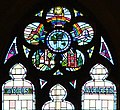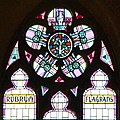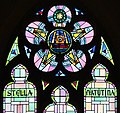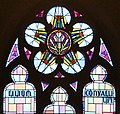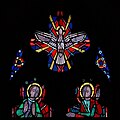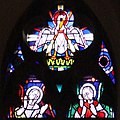Stained glass window of the Marienkirche in Kaiserslautern
The stained glass windows of the Marienkirche in Kaiserslautern are a cycle of leaded glass windows with Marian motifs in the Marienkirche in Kaiserslautern .
Emergence
On September 28, 1944, a bomb attack destroyed all the windows of St. Mary's Church. They were initially replaced by emergency glazing. In 1952 Pastor Engel commissioned the new windows from the Munich artist Wilhelm Pütz . Pastor Engel contributed to the design and coloring, he also designed windows himself. Most of the motifs are taken from the Lauretan Litany . In 1952 and 1953 the side windows were installed first, then the windows in the choir were renewed in 1953 and 1954. The year of completion was the centenary of the dogmatic definition of the Immaculate Conception of Mary .
South window
The windows on the left side of the main nave or in the transept face south.
In the six-pass of the left transept window we see Maria, in the triangular fields above the Madonna two angels, and also two angels in the four-passages below. The inscription “Tota pulchra Maria et macula non est in te” refers to the mystery of the Immaculate Conception of Mary. The verse of the Song of Songs “Everything about you is beautiful, my friend, you have no stain” ( Hl 4,7) was related to Mary. The solemn feast of the Virgin and Mother of God , conceived without original sin , which is celebrated on December 8th, has its origins in the 8th and 9th centuries.
The first aisle window on the south side bears the inscription “Arcus caelestis” (heavenly arch). The sun can be seen above the rainbow, the moon to the left and a star to the right. Under the rainbow the globe with the continents. Below on the right the Speyer Cathedral and on the left a church building. The rainbow is an ancient symbol of the connection between heaven and earth. In the Old Testament (OT) it is set by God as a covenant sign after the flood ( Gen 9: 12-16). As a guarantee of God's grace and as an indication of his glory, the rainbow belongs to the throne of the ruler of the world (cf. Rev 4: 3: "... a rainbow that looked like an emerald arched over the throne (of God)"). The 7 colors were also interpreted as gifts of the Holy Spirit; and the 3 basic colors as a symbol of the Trinity. The unbreakable bond between creator and creature is also a symbol for Maria, as is shown in Matthias Grünewald's Stuppacher Madonna .
The second aisle window bears the inscription "Rubrum Flagrans" ( Burning Bush ). The hand of God can be seen above the burning bush, as well as the divine name JAHWE. According to medieval typology, the burning bush was considered an announcement or model of the Immaculate Conception. In Russian icon painting since the 16th century, Mary is often represented symbolically as a thorn bush that does not burn.
The third aisle window bears the inscription "Stella matutina" ( morning star ). The morning star or sea star is the planet Venus in its morning position - and insofar as it heralds the new day, it is a sign of constant renewal and a symbol of the light that triumphs over the night. In Rev 22:16 Jesus relates this sign to himself: "I, Jesus, am the shining morning star". Pope Gregory the Great takes up the picture again, especially with regard to the resurrection. Mary can also be seen as Stella Matutina, going before Christ. In the Lauretan litany , Maria is called as Stella Matutina. "As is well known, this star precedes the rising of the sun together with the dawn: Mary preceded the coming of the Savior, the rising of the sun of righteousness in the history of the human race." In praise of God , Mary is invoked as a sea star.
The fourth aisle window bears the inscription "Lilium convallium" (Lily of the valleys). This creates a reference to the Song of Songs ( Hld 2,1): “I am a flower of Sharon , a lily of the valleys.” The Sharon is a very fertile plain on the Mediterranean, between Tel Aviv-Jaffa and Haifa . The lily indicates immaculate purity and virgin motherhood. The lily is often seen in the hands of the angel of the Annunciation, Gabriel .
The fifth aisle window bears the inscription "Regina pacis" (Queen of Peace). In the five-pass above, the crown can be seen as an attribute of the queen. In the middle a dove (sign of peace) with an olive branch in its beak (in memory of the end of the flood , Gen 8:11, ( Gen 8:11 EU )). In the Lauretan litany , too , Mary is invoked as Queen of Peace.
The sixth aisle window bears the inscription "Caeli ennorant gloriam Dei" (The heavens tell the glory of God). The last window on the south side, the gallery window, shows the church music: "Caeli ennorant gloriam Dei" (Ps 19,2). The presentation of an organ brochure is clearly visible, including the keyboard of a manual.
Choir window
There are three windows in the choir. In the quatrefoils above, the symbols all-seeing eye are shown as a reference to God the Father (left), "dove" representing the Holy Spirit (center) and "pelican" as a symbol for Christ (right). The left window shows three scenes from the Old Testament, the right window refers to them and shows scenes from the New Testament. Top left is the Fall of Man (Genesis 3), referring to it at the top right, Christ on the cross. At the bottom left, Esther is shown with King Artaxerxes as a model for Mary and at the bottom right, in an extraordinary representation, Jesus can be seen handing Mary a bridal ring. In the middle window Mary is shown as the patroness of the suffering church (below), the quarreling church (middle) and the triumphant church (above).
Four passports:
Old vs. New Testament
Mary as the church patroness
North window
On the north side there are another seven windows:
- Peter
- Rosa mystica
- Foederis arca
- Janua caeli
- Turris davidica
- Vas insigne devotionis
- Magnificat
Individual evidence
- ^ The fateful year 1944 - The attack on September 28, 1944. (PDF) (No longer available online.) In: Wochenmarkt-Kaiserslautern.de. March 22, 2015, archived from the original on September 14, 2016 ; Retrieved November 5, 2017 . Info: The archive link was inserted automatically and has not yet been checked. Please check the original and archive link according to the instructions and then remove this notice.
- ↑ a b Lecture on stained glass windows of St. Mary's Church on November 5, 2017 by Pastor Edmund Janson
- ↑ a b Forstner, Dorothea: The world of Christian symbols. Innsbruck: Tyrolia, 1991, pp. 49-53; P. 109f.
- ↑ John Paul II: Apostolic Exhortation Stella Maris , accessed on November 13, 2017.
- ↑ Walter Dürig: The Lauretanic Litanei. Origin, author, structure and mariological content. Sankt Ottilien: EOS-Verlag, 1990, p. 59f.
- ↑ John Paul II: Encyclical Redemptoris Mater No. 3 , accessed on November 13, 2017.
- ^ "Meerstern, I greet you", in: (Arch) Bishops of Germany and Austria and Bishop of Bozen-Brixen: Gotteslob. Stuttgart: Katholische Bibelanstalt, 2013, No. 524, p. 560.
- ^ Haucke, Manfred: The Lauretanische Litanei: systematic aspects of Marianischer Volksfrömmigkeit, p. 60, in: Haucke, Manfred; Rovira, Germann; Stöhr, Johannes: Sedes Sapientiae. Mariological Yearbook 15 (2011), Vol. 2 ( PDF , accessed on November 13, 2017).
- ^ Lecture by Pastor Edmund Janson on November 12, 2017 on the stained glass windows of St. Mary's Church.


